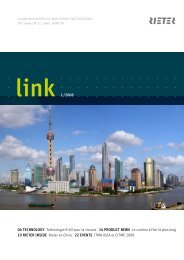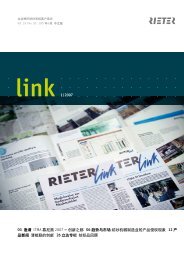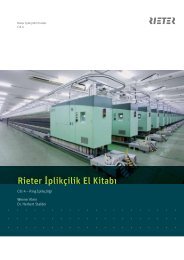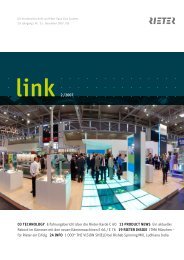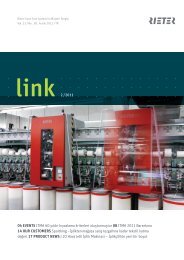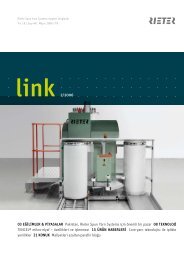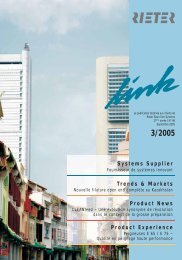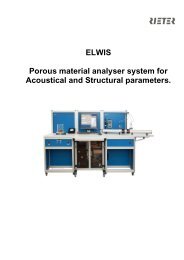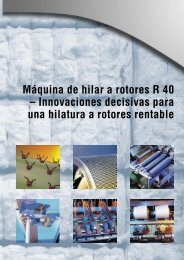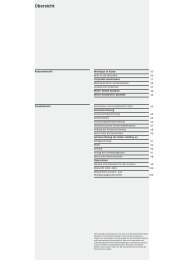You also want an ePaper? Increase the reach of your titles
YUMPU automatically turns print PDFs into web optimized ePapers that Google loves.
4 <strong>LINK</strong> 55 . 2 /2010<br />
RIETER INSIDE<br />
Quality – a <strong>Rieter</strong> tradition<br />
Modern quality assurance involves global, forward-looking planning<br />
throughout the process chain in a way that can be appreciated by everyone.<br />
How does <strong>Rieter</strong> usher old traditions onto new paths?<br />
Fig. 1 Quality<br />
assurance with modern<br />
measuring technology<br />
– D coordinate<br />
measuring instrument<br />
in operation.<br />
The term “quality” is derived from the Latin (qualitas)<br />
and means attribute, characteristic, property,<br />
condition. The attributes a product has to display in<br />
order for customers to be satisfied depend on the individual<br />
customer’s expectations. There is therefore<br />
no such thing as absolute quality, only customerspecific<br />
quality. Quality means meeting the customer’s<br />
expectations. Under-fulfillment of expectations<br />
is out of the question for us. Over-fulfillment should<br />
be our goal, while having due regard for costs.<br />
Examples of quality in everyday spinning operations<br />
A fancy weaving mill producing high-quality shirting<br />
fabrics sets different quality standards for a yarn<br />
from those of a knitting mill using the yarn to produce<br />
T-shirts. In the first case combed ring-spun yarn<br />
made from long-staple cotton with a tensile strength<br />
of 20 cN/tex is used, in the second case a rotor-spun<br />
yarn with 15 cN/tex. Two completely different quality<br />
requirements – but each adapted precisely to the<br />
intended application. The customer’s expectations<br />
in terms of price/performance ratio are met and can<br />
be measured with a testing instrument in the textile<br />
laboratory.<br />
Quality has to be defined<br />
How is quality defined in textile machinery manufacturing?<br />
Here also, customers are only satisfied if the<br />
actual outcome corresponds to their requirements.<br />
Armand V. Feigenbaum (1920), a leading American<br />
theorist in the field of quality management, defines<br />
quality as the customer’s conception, based on his<br />
present experience with a product or service, which<br />
is measured against his spoken or unspoken requirements.<br />
Quality is a moving target in the market environment<br />
and is defined by the customer. This simply<br />
means that when spinning machines are being purchased,<br />
the product has to fulfill both spoken expectations<br />
and unspoken wishes.<br />
What customers require from spinning machines<br />
Diverse requirements are imposed on a product.<br />
Question after question has to be answered before a<br />
purchase is made. The first question of all is whether<br />
the investment is worthwhile for the customer and<br />
how the product performs compared to its competitors.<br />
Whether the product is suitable for its intended<br />
use can be established through references or by customer-specific<br />
tests.<br />
What options does the product offer and how flexibly<br />
can it be used? Is the product service-friendly?<br />
How reliable is the service offering? What additional<br />
facilities does a manufacturer provide, during and<br />
after sales? How attractive is the design of the product?<br />
Has the product been manufactured in an environmentally<br />
friendly way? Have safety guidelines<br />
been adhered to? Is manufacturing quality adequate?<br />
A product’s reliability and durability only become<br />
apparent in operation. In this respect the customer<br />
must be able to count on reliable statements by quality<br />
management and the manufacturer.<br />
Communicative and constantly changing<br />
For 215 years <strong>Rieter</strong> has successfully embodied<br />
these spoken and unspoken customer requirements<br />
in its products. This is a tradition based on our virtues.<br />
Our sales personnel and marketing specialists<br />
have sound textile training, are prepared to listen,<br />
and can empathize with customers’ feelings and ideas.<br />
Our service personnel contribute their feedback<br />
and experience. Personnel in the engineering departments<br />
take concerns seriously and work on improvements.<br />
Good, long-term customer relationships mean that<br />
customers can express their requirements, wishes or<br />
doubts loudly and clearly.<br />
Feedback from customers is incorporated in <strong>Rieter</strong>’s<br />
products. Sometimes not quite as quickly as customers<br />
would like. New ideas are developed quickly,<br />
but field testing and any necessary corrections take<br />
time. The time required, cost and risk are all factors<br />
at work here, and it takes experience and teamwork<br />
to find the optimum solution.



